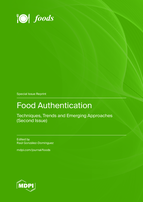Food Authentication: Techniques, Trends and Emerging Approaches (Second Issue)
A special issue of Foods (ISSN 2304-8158). This special issue belongs to the section "Food Analytical Methods".
Deadline for manuscript submissions: closed (20 June 2021) | Viewed by 35179
Special Issue Editor
Interests: metabolomics; mass spectrometry; food authentication; nutrition; polyphenols; neurodegeneration; Alzheimer’s disease; metabolic disorders
Special Issues, Collections and Topics in MDPI journals
Special Issue Information
Dear Colleagues,
Multiple factors can directly influence the chemical composition of foods, and consequently their organoleptic, nutritional, and bioactive properties, including the geographical origin, the variety or breed, and the conditions of cultivation, breeding, and/or feeding, among others. Therefore, there is great interest in the development of accurate, robust, and high-throughput analytical methods to guarantee the authenticity and traceability of foods. For these purposes, a large number of sensorial, physical, and chemical approaches can be used, which must normally be combined with advanced statistical tools. Considering the success and popularity of the Special Issue "Food Authentication: Techniques, Trends and Emerging Approaches" previously published in the journal Foods (https://0-www-mdpi-com.brum.beds.ac.uk/journal/foods/special_issues/Food_authentication_Techniques_Trends_Emerging_Approaches, printed book version with ISBN 978-3-03928-748-2), we now release a Second Issue aimed to gather original research papers and review articles focused on the development and application of analytical techniques and emerging approaches in food authentication. Works dealing with the characterization of food components potentially linked to their traceability and their role in human health are also welcome.
Dr. Raúl González-Domínguez
Guest Editor
Manuscript Submission Information
Manuscripts should be submitted online at www.mdpi.com by registering and logging in to this website. Once you are registered, click here to go to the submission form. Manuscripts can be submitted until the deadline. All submissions that pass pre-check are peer-reviewed. Accepted papers will be published continuously in the journal (as soon as accepted) and will be listed together on the special issue website. Research articles, review articles as well as short communications are invited. For planned papers, a title and short abstract (about 100 words) can be sent to the Editorial Office for announcement on this website.
Submitted manuscripts should not have been published previously, nor be under consideration for publication elsewhere (except conference proceedings papers). All manuscripts are thoroughly refereed through a single-blind peer-review process. A guide for authors and other relevant information for submission of manuscripts is available on the Instructions for Authors page. Foods is an international peer-reviewed open access semimonthly journal published by MDPI.
Please visit the Instructions for Authors page before submitting a manuscript. The Article Processing Charge (APC) for publication in this open access journal is 2900 CHF (Swiss Francs). Submitted papers should be well formatted and use good English. Authors may use MDPI's English editing service prior to publication or during author revisions.
Keywords
- food authentication
- food traceability
- protected designation of origin
- high-throughput methods
- mass spectrometry
- spectroscopy
- food composition







